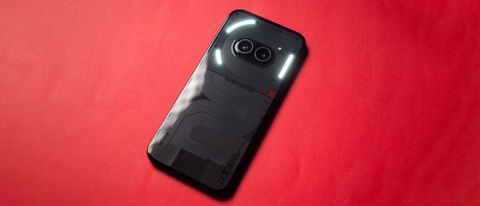Android Central Verdict
The Phone 2a has a similar see-through design and LED lighting at the back as Nothing's other phones, and it instantly catches the eye. While it doesn't have the same materials, you get an excellent in-hand feel, and it's clear that a lot of thought went into the design — both inside and out. The AMOLED panel is a delight to use, the phone is fluid like no other budget device, and you get two usable cameras at the back. It also holds up incredibly well at gaming, and the battery lasts over a day. The best part is the software: the interface is clean, there's no bloatware, and you get plenty of custom features that make using the phone that much more enjoyable. Yes, the Phone 2a is a budget phone, but it sure doesn't look or feel like one.
Pros
- +
Best-looking budget phone available today
- +
Good 120Hz OLED panel with ultra-thin bezels
- +
Standout cameras at the back
- +
Good battery life
- +
Customizable software with no bloatware
- +
Decent hardware
- +
Glyph lighting is fun
Cons
- -
Plastic back is a dust magnet
- -
No bundled charger
- -
Not available in the U.S.
Why you can trust Android Central
It seems like Nothing can do no wrong at the moment. The three-year-old brand clearly knows how to market its devices, and while its market share isn't on par with entrenched rivals, Nothing's devices get an outsized portion of the mind share.
A lot of that is down to Nothing's clever marketing, but the design-focused approach the brand takes to all of its products makes a big difference as well. The Phone 1 highlighted this incredibly well, and the LED lights at the back, combined with the unique see-through aesthetic, made it an instant hit. Nothing followed it up with the Phone 2 last year, and it was catered to the high-end segment, delivering a more polished design and better hardware.
For 2024, Nothing is setting its sights on the budget segment. The Phone 2a shares a lot of the same great features that made its predecessors stand out — including a striking design and clean software — but it's the affordability that makes it an enticing choice. There's clearly no shortage of choice in the budget segment, but most phones still run middling hardware or outdated software with overt customization.
The Phone 2a is challenging those norms, and after using it for two weeks, it's clear to me that there's no reason to buy any other device in this category.
Disclaimer
This review was made possible with a review unit provided by Nothing India. The company did not see the contents of the review before publishing.
Nothing Phone 2a: Pricing and availability

Nothing unveiled the Phone 2a on March 5, 2024, and the phone is now available in most global markets where the brand has a presence. It costs £319 in the U.K. for the 8GB/128GB version, and the 12GB/256GB model costs £349. The Phone 2a is available in other countries in Europe as well, where it costs €349 for the version with 8GB of RAM and 128GB of storage and €399 for the 12GB/256GB edition.
India is a big market for Nothing, and the 8GB/128GB version of the Phone 2a retails for ₹23,999, and the 12GB/256GB version costs ₹27,999. Nothing sells a unique 8GB/256GB version of the Phone 2a in India, and that particular variant is available for ₹25,999.
Nothing sells the Phone 2a in select countries in the Middle East and Southeast Asia, and the one region where you can't buy the device in North America. Nothing has revealed why it isn't launching the Phone 2a in the U.S., and it has to do with the fact that the brand doesn't have a partnership with a carrier yet.
Nothing Phone 2a: Design
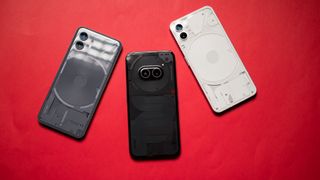
Nothing is best known for its design prowess, and the brand did a great job bringing its unique ethos to the budget segment. The end result is that the Phone 2a doesn't really look or feel like any other budget phone. It has a similar see-through design as the Phone 1 and Phone 2 but with a few tweaks.

As it doesn't come with wireless charging, the back has a different pattern that instead highlights the cable that connects the battery. I talked to Nothing co-founder Akis Evangelidis about the design, and he mentioned that the inspiration for the back came from the New York City metro's subway maps. It looks distinctive, and the other area of differentiation is the camera housing that's now centered.
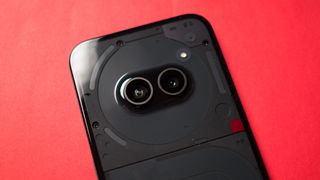
The camera housing sits in the middle of the NFC coil, and the positioning means there is no wobble when using the phone on a flat surface. The black version doesn't quite have the same presence as the white option, and the main issue I have with the design is that the back is a smudge magnet.
Nothing eschewed glass and went with a plastic back on the Phone 2a, and while that's fine, the glossy finish means the back is constantly covered in smudges. It also picks up dust easily, and I've had to use a microfiber cloth on my desk because of the number of times I've had to clean the phone over the last two weeks. The only other phone in recent years that got anywhere as dusty was the Redmi K20.
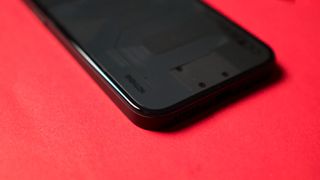
Having said that, I will mention that the Phone 2a has a great in-hand feel; the back has a slight curve where it meets the mid-frame, and the rounded edges make it highly comfortable to hold and use the phone. The matte sides go a long way in this regard, and they feel great — Nothing should have used a similar coating at the back.
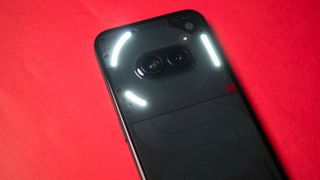
The sides are also made of plastic, but Nothing says the Phone 2a is using an aluminum mid-frame to increase structural rigidity. At 190g, the phone isn't particularly heavy and has good weight distribution. It has IP54 ingress protection, and while it doesn't withstand a dunk in the pool, it does a decent job of weathering the elements.
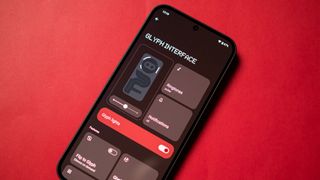
Obviously, a big part of the design has to do with the LED lights at the back, and while the Phone 2a doesn't have as many LEDs as the Phone 2, the Glyph lighting is just as fun to use. Now, I don't necessarily find the feature to be useful as I don't leave my phone face-down on a table, but the addition of a timer made it less gimmicky in my use case. The ability to see a visual indicator as the timer counts down is a great use of the LED lights at the back, and I actually ended up using it quite a bit.
On the whole, Nothing managed to stay true to its design heritage while still managing to deliver a phone that's fun to use. The Phone 2a is easily the best-looking budget phone around, and the unique styling combined with the attention to detail give it a distinct edge.
Nothing Phone 2a: Display
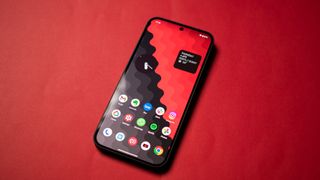
Nothing lavished a lot of attention up front as well, and the Phone 2a has a 6.7-inch AMOLED panel that goes up to 120Hz. While that's a standard feature in this segment, what makes the Phone 2a stand out is the symmetrical bezels on all sides — it adds to the upmarket look of the phone.
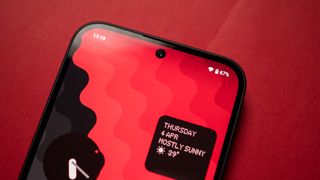
There's no LTPO tech, but you can choose between High and Standard modes, and the former ensures the refresh is locked to 120Hz most of the time. Colors are vibrant out of the box, and you can tweak the color warmth to your tastes. You get an always-on mode, but there isn't much in the way of customizability. That said, Nothing has a lot of custom widgets on the lock screen, and these make up for the lack of AOD options.
The Phone 2a does a good job with media, and I didn't run into any issues streaming HDR10+ content. Playing games is just as enjoyable, and the phone delivers excellent sustained performance. There's stereo sound on offer, and it gets loud enough that you don't need to use earbuds for casual gaming or streaming the occasional video.
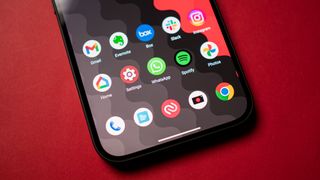
Another area where the Phone 2a has a strong showing is brightness figures. It goes up to 1,100 nits in outdoor use, and while that isn't as high as the Redmi Note 13 Pro, it is more than adequate — I had zero issues with the screen under harsh sunlight. Just like Xiaomi, Nothing offers PWM dimming, with the Phone 2a able to go up to 1920Hz.
The screen is protected by a layer of Gorilla Glass 5, and it has an optical fingerprint module. The only quibble about the sensor is that it is located a little too low on the screen, making it awkward to access.
PWM measurements
Section written by Nicholas Sutrich.
Like the Nothing Phone 1 and Phone 2, the Nothing Phone 2a offers DC-like dimming at high brightness levels and 1,920Hz PWM dimming below that. 50% brightness and above uses a single-pulse dip that emulates DC-style dimming, but the Nothing Phone 2a has deeper modulation rates than the Nothing Phone 2 as evidenced in my comparison video.


At 49% brightness and below, the phone switches to 1,920Hz PWM dimming with very low modulation rates. In fact, I found that 49% brightness was one of the most comfortable brightness levels on any modern OLED smartphone display. As you can see from the graph above, the graph is quite close to a flat line and, therefore, extremely comfortable even for PWM-sensitive folks.
At 49%, I found outdoor brightness to be comparable to some cheaper LCD panels. It's not super visible, but it'll work if you're super sensitive to low PWM rates and the DC-like dimming above, which bothers your eyes as well.
Nothing Phone 2a: Performance and battery

The Phone 2a has the distinction of being the first Nothing phone to feature MediaTek hardware. This isn't too surprising considering Qualcomm just doesn't have anything in the budget segment that is on par with MediaTek at the moment, and as a result, most budget phones now use the Dimensity 8300 or 7200.
In the case of the Phone 2a, Nothing is using a custom version of the Dimensity 7200, dubbed the Dimensity 7200 Pro. It uses the same set of cores: you get two Cortex A715 cores at 2.8GHz, and the efficiency side is handled by six Cortex A510 cores that go up to 2.0GHz. The phone has 8GB of RAM and 128GB of storage with the base model, and I'm using the 12GB/256GB variant.
| Category | Nothing Phone 2a |
|---|---|
| OS | Nothing OS 2.5.4, Android 14 |
| Display | 6.7-inch 120Hz AMOLED, 2412x1080, HDR10+, 1100 nits HBM mode, 1300 nits max, Gorilla Glass 5 |
| Chipset | MediaTek Dimensity 7200 Pro, Mali-G610, 4nm |
| RAM | 8GB/12GB |
| Storage | 128GB/256GB |
| Rear camera 1 | 50MP f/1.9 Samsung GN9, OIS, 4K at 30fps |
| Rear camera 2 | 50MP f/2.2 Samsung JN1, wide-angle |
| Front camera | 32MP f/2.2 Sony IMX615 |
| Ingress protection | IP54 dust and water resistance |
| Connectivity | 5G bands, Wi-Fi 6, Bluetooth 5.3, NFC |
| Security | Optical in-screen sensor |
| Audio | USB-C, stereo sound |
| Battery | 5000mAh battery, 45W USB PD 3.0 charging tech |
| Dimensions | 161.7 x 76.3 x 8.6mm, 190g |
| Colors | Black, White |
While the Dimensity 7200 is a known quantity, Nothing definitely managed to make the most of the hardware, and the Phone 2a is optimized like no other budget phone I've used to date. There is absolutely no lag whatsoever, and the level of fluidity immediately takes me back to the heyday of OxygenOS. The Phone 2a just doesn't feel like a budget device in this area, and that translates to gaming as well — it is able to deliver much better-sustained performance than any other budget phone.
Yes, there are issues if you play demanding titles at the highest settings, but turn down the visuals to medium, and you get smooth framerates without any jitter. While the device isn't able to run 3DMark's Solar Bay test, the Wild Life Extreme stress test had a stability of 99.8%, and there was no overheating.
The synthetic workloads don't reveal the entire picture, but using the Phone 2a has been a revelation. If you've been frustrated by budget phones that were laggy or otherwise unstable in daily use, you need to consider switching.
| Category | Nothing Phone 2a | Vivo V30 |
|---|---|---|
| PCMark Work 3.0 (Overall) | 13898 | 10560 |
| PCMark Work 3.0 (Web Browsing) | 16009 | 7950 |
| PCMark Work 3.0 (Video Editing) | 5246 | 5866 |
| PCMark Work 3.0 (Writing) | 19519 | 12225 |
| PCMark Work 3.0 (Photo Editing) | 24538 | 23065 |
| Geekbench 6 (single-core) | 1125 | 1099 |
| Geekbench 6 (multi-core) | 2412 | 3144 |
| 3DMark Wild Life Extreme (score) | 1144 | 1491 |
| 3DMark Wild Life Extreme (FPS) | 6.85 | 8.935 |
Rounding out the connectivity, there isn't a whole lot missing on the device; it has Wi-Fi 6, Bluetooth 5.3, NFC, and the requisite 5G bands. I didn't notice any issues with cellular connectivity or any of the other radios, and while the vibration motor isn't as detailed as what you get on high-end devices, it is better than most budget phones.

Switching over to the battery, the Phone 2a has a 5,000mAh battery — the largest yet on a Nothing phone — and it easily lasts over a day with ease. Even with heavy use, I didn't feel the need to charge the device before turning it in for the night, and there's no reason to worry about battery longevity whatsoever.
The phone uses 45W charging tech, and a full charge takes a smidgen over an hour, hitting the 50% mark in 25 minutes. Obviously, a number of phones in this segment charge faster, but the Phone 2a isn't too far behind its rivals. What is annoying, though, is the lack of a charger in the box.
Nothing doesn't include a charger with any of its devices, but its earlier phones weren't aimed at the budget segment. Having to buy a charger to use with the phone is irksome, but as the device relies on the USB PD standard, any decent PD charger is more than adequate.
Nothing Phone 2a: Cameras
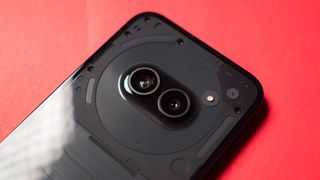
The Phone 2a features a 50MP Samsung GN9 sensor with OIS, and it uses the same 50MP Samsung JN1 wide-angle lens as the Phone 2. The fact that you get two usable lenses at the back is a big deal; most budget phones only focus on the main camera, with the auxiliary lenses barely meriting any attention.
Like other devices in this segment, you miss out on 4K video at 60fps, and you don't get many extras in the way of shooting modes or custom filters. That said, the interface is easy to navigate, you get toggles for the two lenses — the phone uses the main camera to take shots at 2x zoom — flash, HDR, and effects.






Photos taken in daylight have plenty of detail, and Nothing continues to prioritize overly saturated colors, so you don't necessarily get accurate color rendition. That said, the resultant shots look pretty good, and they're great for sharing on social media. The wide-angle lens does a great job in daylight scenarios, and that's not astonishing considering the caliber of the hardware.
That said, you don't get as much detail; the tuning is too aggressive at times, and foliage, in particular, looks artificial. The phone redeems itself with its low-light prowess, delivering photos with minimal noise levels and plenty of detail. Night mode kicks in automatically once ambient light is under a certain threshold, and while the camera isn't quite on par with the likes of the Pixel 7a, it is close.
Nothing Phone 2a: Software

The Phone 2a runs Nothing OS 2.5 based on Android 14 out of the box, and it is quickly turning into one of my favorite Android skins. Nothing didn't mess with the overall aesthetic, so you get a clean UI that's similar to what's on the Pixels. Where Nothing differentiated the interface is by adding a ton of visual flourishes, and this is particularly noticeable with widgets.
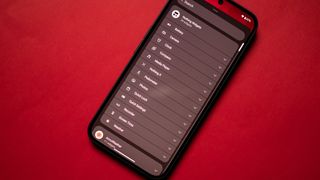
Nothing has a set of custom widgets that are beautifully designed, and they liven up the interface quite a bit while providing contextual information. You also get monochrome icons that are terrific, but like all icon packs, there are a few missing apps, and the inconsistent styling is a bit weird. That said, Nothing did a better job than Google in this area.

The notification shade has large tiles, and a double pull-down gesture surfaces eight in total, with the two at the top prominently highlighted. Pressing the Bluetooth tile pulls up the device menu without needing to go into the settings, and while this feature has been around for a while, it's still a welcome tweak.

There are plenty of custom additions throughout the interface, and it's clear that Nothing put a lot of thought into which areas of the UI to address. The result is that the Phone 2a has the best software of any budget phone I've used in a very long time. It's a rarity to get a clean interface in this segment, much less one that's brimming with exciting features. Best of all, there's no bloatware to be found.
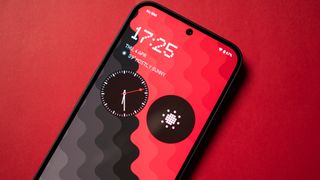
On that note, Nothing is doing a fantastic job rolling out consistent updates to the phone. I've had the phone for just over three weeks now, and it has already received two updates. Again, I can't think of another budget phone that has picked up as many updates.
Nothing guarantees three Android platform updates, and that means the Phone 2a will make the switch to Android 17 when that becomes available. To put things into context, the Redmi Note 13 Pro won't get any updates beyond Android 15.
Nothing Phone 2a: The competition

Out of all the budget phones I used this year, the only one I'd consider recommending is the POCO X6 Pro. I really like the design; the hardware is a smidgen more powerful than the Phone 2a, the battery charges faster, and the main camera is just as good. The software isn't as refined, and it won't get as many software updates, but other than that, the X6 Pro is a decent alternative.
Nothing Phone 2a: Should you buy it?

You should buy this if:
- You want the best budget phone currently available
- You need a phone that's great for gaming
- You need good cameras at the back
- You're looking for clean software that's customizable
- You need a vibrant 120Hz OLED
You shouldn't buy this if:
- You want a charger bundled in the box
- You live in the U.S.
The best way to sum up the Phone 2a is that it doesn't feel like a budget phone. Nothing did a marvelous job optimizing the hardware, and the phone is just as fluid as the Phone 2 in daily use — no small feat. The design is evocative, the AMOLED panel is terrific, and the cameras take great photos in most situations.
However, the clear differentiator is the software; Nothing OS 2.5 offers the best software experience in the budget segment, and there isn't another device that comes close in this area. More than anything else, the clean software coupled with timely updates is what gives the Phone 2a a sizeable advantage over its rivals.
There's no shortage of budget phones with great hardware, but they all fall short when it comes to the software. That's why the Phone 2a is such a big deal; the software on offer is on par with the best Android phones, and you also get terrific hardware that delivers the performance you need.
There aren't any major drawbacks with the Phone 2a, and that in itself differentiates it considerably from the rest of the pack. There really is no reason to consider any other device in this segment.

The Phone 2a delivers everything you need from a budget phone. The design stands out considerably, the hardware is terrific, you get two great cameras at the back, and the software is easily the best in this segment.

Harish Jonnalagadda is a Senior Editor overseeing Asia at Android Central. He leads the site's coverage of Chinese phone brands, contributing to reviews, features, and buying guides. He also writes about storage servers, audio products, and the semiconductor industry. Contact him on Twitter at @chunkynerd.
- Nicholas SutrichSenior Content Producer — Smartphones & VR
-
Daniel Gomes Since you asked the question "why would you buy anything else?", I'll give you the answer:Reply
1. Poor cameras - for the price the cameras are average. The ultra wide is especially poor and lacks auto focus. The normal camera is just OK in good lighting like ALL other phones at this price. The capture and processing of photos takes a long time for some reason and starting a video recording starts with jittering for a second. In other words, in this class the camera is average to poor.
2. The 7200 processor is average for the class in the way the SD 695 is the average for the class, but Poco notably offers MUCH better CPU's at this price, so there are better CPU's available.
3. Average display - according to various reviews I've seen the display is ok, but not the best in class and it doesn't go especially bright, even in sunlight. The competition generally beats it.
4. Accessories - many phones in this class come with chargers, cables and a case in the box. This doesn't. You can only get the accessories from Nothing online, and pay the postage and import duties as well. Whereas at least with Samsung in all countries you will find many shops with Samsung cases, chargers etc with ease. And the other makes typically are well represented on Aliexpress so you could order from there if you cannot find locally.
5. Repairs - This is a big one if comparing to Samsung. For example the A35 costs the same as the 2a yet Samsung has local repair centres in every country and most offer 1 hour walk in service for common items like screens and batteries. The other makes generally don't have this but 3rd party repairers typically will have parts for popular phones like Xiaomi. Whereas with the Nothing 2a you have to courier the phone to Nothing and wait 3 - 6 weeks (!!) to get your phone back. And if it was your fault or maybe the phone is 2 years old and you just want a new battery, you will pay the courier costs....
tbh if you can, buy Samsung because they have the best OS upgrade policsy, One UI 6, the best repair options, and easily accessible accessories.
Note: I live in Europe (Cyprus) and this is the situation. -
JRon Reply
You raise very good points, especially the repair situation. That alone is enough to discourage a lot of people from buying this. It is risky in this respect. I'm in the U.S., and I was actually going to replace my old S21 with the A55, but Samsung decided that they are not going to bring the A55 to the U.S. market... at least no time soon.Daniel Gomes said:Since you asked the question "why would you buy anything else?", I'll give you the answer:
1. Poor cameras - for the price the cameras are average. The ultra wide is especially poor and lacks auto focus. The normal camera is just OK in good lighting like ALL other phones at this price. The capture and processing of photos takes a long time for some reason and starting a video recording starts with jittering for a second. In other words, in this class the camera is average to poor.
2. The 7200 processor is average for the class in the way the SD 695 is the average for the class, but Poco notably offers MUCH better CPU's at this price, so there are better CPU's available.
3. Average display - according to various reviews I've seen the display is ok, but not the best in class and it doesn't go especially bright, even in sunlight. The competition generally beats it.
4. Accessories - many phones in this class come with chargers, cables and a case in the box. This doesn't. You can only get the accessories from Nothing online, and pay the postage and import duties as well. Whereas at least with Samsung in all countries you will find many shops with Samsung cases, chargers etc with ease. And the other makes typically are well represented on Aliexpress so you could order from there if you cannot find locally.
5. Repairs - This is a big one if comparing to Samsung. For example the A35 costs the same as the 2a yet Samsung has local repair centres in every country and most offer 1 hour walk in service for common items like screens and batteries. The other makes generally don't have this but 3rd party repairers typically will have parts for popular phones like Xiaomi. Whereas with the Nothing 2a you have to courier the phone to Nothing and wait 3 - 6 weeks (!!) to get your phone back. And if it was your fault or maybe the phone is 2 years old and you just want a new battery, you will pay the courier costs....
tbh if you can, buy Samsung because they have the best OS upgrade policsy, One UI 6, the best repair options, and easily accessible accessories.
Note: I live in Europe (Cyprus) and this is the situation.
Since I was in the market for a new phone, I shopped around and discovered the Nothing Phone 2. I was going to buy the Phone 2a, but it's not officially certified in the U.S. so I bought the Phone 2 instead.
I'm extremely happy with my purchase and I much prefer Nothing OS's lightweight software approach over Samsung's heavy-handed approach which many consider to be bloatware, especially all the carrier bloatware, although OneUI is very polished and nice.
In all the years I've owned a smartphone, I've never had to have one repaired as I never drop my phone, hence the reason I never buy cases anymore and the Nothing Phone 2 comes with a pre-installed screen protector.
Thankfully, in the U.S. there are stores I can take it to for repair if that ever became a need, but this situation is different around the world.
By the way, the processor and cameras on the Phone 2 are significantly better than on the Phone 2a, another reason why I passed on the Phone 2a as well. I've been doing heavy gaming on the Phone 2 and the phone never gets too warm or lags. Overall, I believe it is a great option in North America, as we don't have as many options as say India as an example. And our greedy phone carriers are to blame. -
kirk781 Nothing, despite focusing on India, doesn't have a significant market share here as well. Carl Pei's original Oneplus is more firmly entrenched and this phone still is slightly expensive when it comes to middle tier standards(Atleast from the Indian market). And honestly, faster phones exist at this price point here. Chinese OEMs which corner significantly more market share (and bundle charger as well :p) offer more product ranges. Their products might sometimes be full with bloat ware or heavily modded skins but most common folks hardly care. After all, even Samsung bunches in a duplicate of each Google app even in it's flagship phones and stoops to lower levels for it's budget offerings.Reply -
JRon Reply
I agree. I am in the U.S. market and I recently purchased a Nothing Phone 2 and returned it. I just feel other phones like the OnePlus 12R offer a superior hardware and software experience.kirk781 said:Nothing, despite focusing on India, doesn't have a significant market share here as well. Carl Pei's original Oneplus is more firmly entrenched and this phone still is slightly expensive when it comes to middle tier standards(Atleast from the Indian market). And honestly, faster phones exist at this price point here. Chinese OEMs which corner significantly more market share (and bundle charger as well :p) offer more product ranges. Their products might sometimes be full with bloat ware or heavily modded skins but most common folks hardly care. After all, even Samsung bunches in a duplicate of each Google app even in it's flagship phones and stoops to lower levels for it's budget offerings.
